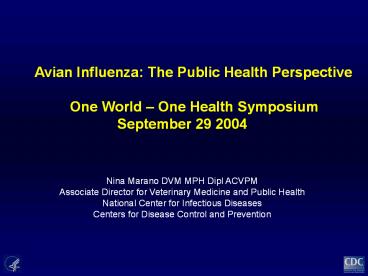Avian Influenza: The Public Health Perspective - PowerPoint PPT Presentation
Title:
Avian Influenza: The Public Health Perspective
Description:
Avian Influenza: The Public Health Perspective – PowerPoint PPT presentation
Number of Views:44
Avg rating:3.0/5.0
Title: Avian Influenza: The Public Health Perspective
1
Avian Influenza The Public Health Perspective
One World One Health Symposium
September 29 2004
Nina Marano DVM MPH Dipl ACVPM Associate Director
for Veterinary Medicine and Public
Health National Center for Infectious
Diseases Centers for Disease Control and
Prevention
2
Influenza in the United States, 2003-04
3
2003-04 Domestic Influenza Season
- Why was this season so challenging?
- New recommendations for pediatric vaccination
(6-23 month old), pregnancy vaccination (1st
trimester) - Early onset
- Public media concerns about deaths in children
- Mismatch between vaccine and circulating A(H3N2)
strain - Perception of increased severity
- Shortage of inactivated vaccine at time of high
demand - Concern about avian influenza
4
2003-04 U.S. Influenza Activity
- Activity began unusually early
- For week ending Dec. 20, 2003, number of states
reporting widespread influenza activity was
higher than for any week during past 10 years - Influenza-related deaths were higher than for
last three mild influenza seasons but lower
than for previous season in which H3N2 viruses
predominated - Highest ILI attack rates were among children and
young adults 134 lab-confirmed deaths in
children lt16 years of age
As estimated by reports from 122 cities
reporting system
5
U.S. Influenza Surveillance
State and Territorial Epidemiologists
Sentinel Providers
Vital Statistics Registrars
Health Departments
CDC
Laboratories
Other
Public Health Officials
Public
Physicians
Media
6
Influenza-like IllnessReported by Sentinel
Providers
7
Pediatric Influenza-Associated Mortality and
Virologic Activity, U.S. 2003-04 Season
8
WHO/NREVSS Collaborating LaboratoriesNational
Summary, 2003-04
9
Reported Influenza Activity
Week ending October 18, 2003
Week ending November 29, 2003
Week ending December 20, 2003
Week ending February 7, 2004
No Report
Sporadic
Regional
Widespread
No Activity
Local
10
(No Transcript)
11
http//www.cdc.gov/flu/avian/protectionguid.htm
12
Worker Protection Recommendations
- Use of personal protective equipment
- Vaccination for influenza
- Administration of antivirals
- Surveillance among poultry workers
- Evaluation of workers who develop a febrile
respiratory illness with 7 days of last exposure
13
Enhanced U.S. Surveillance, Diagnostic
Evaluation, and Infection Control Precautions for
Avian Influenza A (H5N1)
- Testing for avian influenza A (H5N1) is
indicated for hospitalized patients with - Radiographically confirmed pneumonia, acute
respiratory distress syndrome (ARDS), or other
severe respiratory illness for which an alternate
diagnosis has not been established, AND - History of travel within 10 days of symptom onset
to a country with documented H5N1 avian influenza
in poultry and/or humans
14
Enhanced U.S. Surveillance, Diagnostic
Evaluation, and Infection Control Precautions
for Avian Influenza A (H5N1)
Testing for avian influenza A (H5N1) should be
done for hospitalized or ambulatory patients
with Documented temperature of gt38C
(gt100.4F), AND gt of the following Cough,
sore throat, shortness of breath, AND History
of contact with poultry (e.g., visited a poultry
farm, a household raising poultry, or a bird
market) or known or suspected human
case of influenza A (H5N1) in an H5N1-affected
country within 10 days of symptom onset.
15
http//www.hhs.gov/nvpo/pandemicplan
16
HHS Orders Avian Flu Vaccine Doses As Preventive
Measure 9/21/2004 111400 AM
17
ArboNet Surveillance for West Nile Virus 1999-2003
2000
1999
2001
2002
2003
Human WNV infections
WNV animal or mosquito activity
18
Concern over Reassortment of Avian Influenza
Viruses
- Needed
- A swine surveillance system
- To detect antibody to H5 and other influenza
viruses - Serum samples for antibody
- Respiratory swabs for virus isolation
- Confidentiality of country of origin protected
- Regional laboratories be used for testing
isolates would be shared with WHO Reference
laboratories for genomic sequencing to look for
evidence of reassortment
19
(No Transcript)
20
Summary
- We must be prepared to face the next flu pandemic
and preparedness plans are essential - Humans
- Occupational safety, surveillance, infection
control and prophylactic measures are key
components to contain spread - Animals
- Swine studies are needed to assess viral
reassortment - An integrated human animal AI surveillance
system is needed
21
Acknowledgements CDC Jim Hughes,
MD Steve Ostroff, MD Keiji Fukuda, MD Nancy Cox,
MD Lisa Delaney, MD USDA Tom
Gomez, DVM
http//www.cdc.gov/flu/

